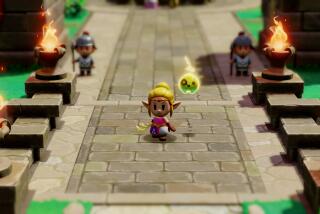Bewitching Players With Storytelling
- Share via
As frightening as it was for the Wayans brothers to be given their own film, something even more terrifying lurks in the shadows of Tinseltown: the “Blair Witch” trilogy. And as with all blockbuster big-screen franchises, a video-game conversion was a must. Tim Gerritsen of Human Head Studios headed the transfer of “The Blair Witch Project 2: Book of Shadows” from film to video game.
Question: Regarding movie licensed properties, how much of a title’s composition should be recycled and how much fresh content should be created by the developer?
Answer: If a game rehashes the same material you’ve seen before, it’s a waste of time. Ideally, a product should offer a wealth of fresh content that builds on an existing franchise’s popularity. For the “Blair Witch” series, we’ve worked with Haxan Films to ensure the adventures are unique yet remain true to the spirit of the movies.
*
Q: Why would fans of the movie want to play the interactive version?
A: To explore the background mythology of the Blair Witch at great length. While the films only touch on past events, the games take you there. Burkittsville’s been a hotbed for paranormal activity for years. The trilogy lets players learn the truth behind the legends in a hands-on context.
*
Q: How closely does the product mirror its namesake?
A: We actually didn’t try to retread any ground. We did, however, try to retain the same sense of creepiness and feel. But a game experience is very different from a movie experience. It has to be interactive. Although it’s important to scare the player, if they weren’t allowed to confront their tormentors, what fun would the frights be?
*
Q: What special nuances were used to make the game as scary as the film?
A: Lots of storytelling tricks. For example, we create an interactive sequence that leads the player down a path, projecting the illusion that they’re making progress. Then something pops out, and they lose control of the situation. Also, there’s the dangers you hear but never see. Creepy visuals, such as fleetingly glimpsed images that may be real or imagined, also work well.
*
Q: Were any cinematic qualities applied to the production of this game?
A: A lot of it’s just basic Filmmaking 101, things that a first-year film student would know. We had to get old-school and use some of the Hollywood tricks made popular in the 1920s and ‘30s--a camera tilting slowly up a villain to make them seem more imposing, unexpected visitors popping into the frame, use of light and shadow, etc.
*
Q: Is making a game comparable to making a movie?
A: Not to a great extent. The basic principles of cinematography have been the same for decades. People know how cameras work. But the game industry’s always changing. In our business, the proverbial camera is reinvented with every product. Technique has to keep up with technology. We work within constantly fluctuating boundaries, something that’s not so applicable to Hollywood.
*
Q: What’s the hardest part for a designer about telling a good, spooky tale?
A: Finding the right mix of action and adventure. Products like “Alone in the Dark” go for a suspenseful approach, while “Resident Evil” is more like a George Romero film. Both go over splendidly with players. Therefore, it’s difficult to decide where to draw the line.
*
Scott Steinberg is a freelance writer specializing in video games.
More to Read
Only good movies
Get the Indie Focus newsletter, Mark Olsen's weekly guide to the world of cinema.
You may occasionally receive promotional content from the Los Angeles Times.










